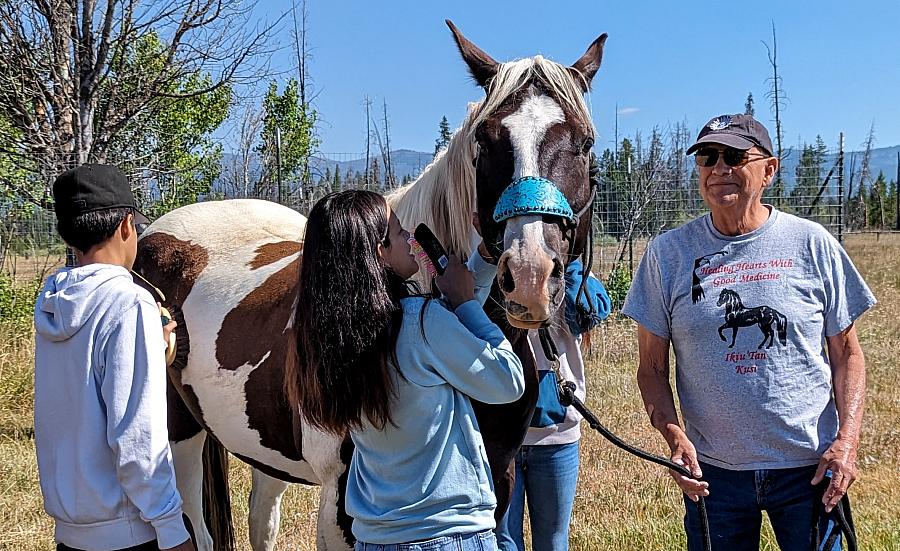What is the role of survivors in healing historical trauma?

John Spence working with youth and horses in rural Oregon last year.
Photo courtesy Nancy Marie Spears/The Imprint
Like millions of Indigenous Americans, John Spence survived this country’s Native displacement and tribal termination policies of the last century. He considers himself a product of Indian boarding schools — his parents met at one in Salem, Oregon. Now retired after decades as a licensed clinical social worker, he runs an equine psychotherapy program for Native teens affected by drug and alcohol use and mental health struggles.
“They hear my story right away,” he said. “I’m 82, I’m from the Fort Belknap Reservation. I rodeoed for 14 years. I’m sober for 40 years. If they just hear that a little bit, a lot of these guys want to hang out with me.”
Spence describes this approach as “Indigenized” social work: “Culture is prevention and culture is treatment. We totally believe that. And we practice that.”
Corbett O’Toole contracted polio at age 2, in an era when disabled people had scant access to public spaces. There were few accessible restrooms, no sidewalk curb cuts, no sign language interpreters at public meetings — compounding challenges that hindered civic life. Today, at 72, O’Toole proudly describes herself as a queer disabled elder who supports not just disability rights but disability justice.
“I understand the ways that having a disability allows the world to create situations that are going to traumatize you,” she said. “But to me, my personal belief is empowered disabled people are the change agents. I want disabled people to know that they are fabulous as they are, that they have superpowers, that they are survivors just by being out of an institution today.
“I often say my generation is the first generation that has the possibility of living our entire lives outside an institution.”
Spence and O’Toole were rooted in the San Francisco Bay Area’s civil rights movements of the 1960s and 70s — from the 18-month Native takeover of Alcatraz Island to the occupation of a federal office building by 150 disabled people for 25 days. These actions ultimately helped bring about changes in laws and policies that improved the nation’s human rights landscape, from the ending of tribal termination policies to the passage of the Americans with Disabilities Act.
Now, after lifetimes of action and advocacy, both elders still work to help new generations heal from — perhaps prevent — further historical and societal trauma.
Fixing broken systems
California has a complex, checkered history when it comes to systemic causes of harm. The most populous state has led the nation in some of the most devastating social policies of the modern era, including the mass incarceration of youth and adults. But the state has also been a leader in reforming social injustices of the past, as recent youth sentencing and decarceration laws demonstrate.
A case in point is the little-acknowledged California Rancheria Termination Acts of the 1950s and 60s. Under these policies, 44 Indigenous tribes were “terminated” — essentially stripped of their tribal status. But now California is among the few U.S. states to establish a “Truth and Healing Council” to address historical trauma that continues to impact Indigenous lives.
As a reporter who has covered the effects of both youth violence and incarceration on communities for decades, I want to better understand the roles survivors can play in addressing trauma. My questions are many. But among them are these: Are survivors of harmful systems those best suited to fix them? Should it even fall on them to do such reform work? While “lived experience” has become an oft-heard phrase, how does playing the role of reformer impact survivors’ mental health?
For my 2024 California Health Equity project, I’m working with my niece and co-producer Mara J. Reynolds — along with several guest reporters — to produce “Elders,” a series of long-form documentary podcasts. The series focuses on individuals like Spence and O’Toole who work to address trauma, addiction and other mental health issues stemming from factors as diverse as youth incarceration, discrimination, Indigenous displacement, racism and family-disrupting child welfare practices.
An important piece of the project is engagement: online and in-person conversations with members of communities related to each episode’s focus. These will include people impacted by the programs and institutions in which our subjects work; members of their personal networks; other elder survivors and the new generations taking up their mantle
We hope these stories will serve as inspiration for people who want to address historical trauma in their own communities. “Maybe the opposite of addiction isn't necessarily healing,” notes Lakota elder Jon Eagle. “Maybe it's connection.”